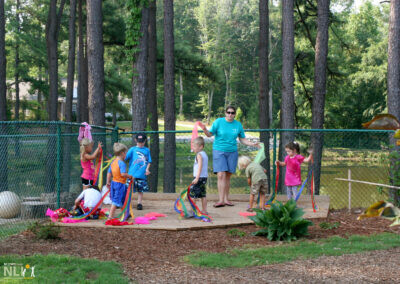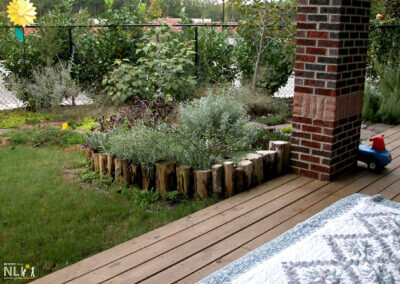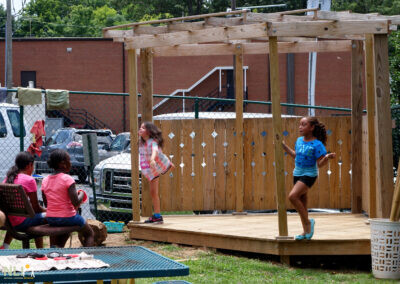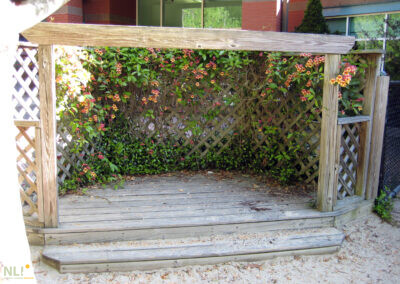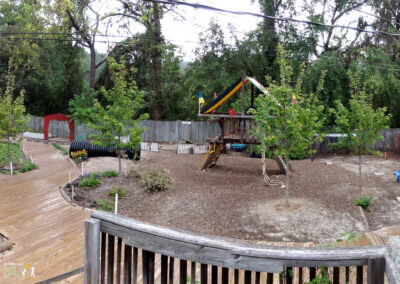Infosheets
22. Decks, Stages, & Porches
Deck/stage settings provide dry, off-the-ground, multipurpose places for informal play, gathering, and classroom activity. Settings can be constructed of dimensioned or composite lumber, with lattice, see-through sides if needed. Settings may be covered or semi-covered, with added seating and/or storage. Stages encourage socio-emotional dramatic play by providing a safe space for emotional expression, where children can create stories, put on shows, dress up, and act out.
MATERIALS
Use high-quality lumber that is knot-free and pressure-treated. Pressure-treated wood is low-cost but also requires maintenance and is susceptible to pests and warping in the hot sun. Composite lumber such as Trex™ has long been used for horizontal surfaces such as decks and is rot/insect resistant. Though composite materials are initially more expensive, they are relatively maintenance-free. Fortunately, several types of treated lumber are available as an alternative, including thermally modified, polymerized, or acetylated lumber (see HARD CHOICES for more information).
6-inch wide boards are ideal for most decks, requiring fewer fasteners than 4-inch boards. Buy lumber that runs the full length of the deck to avoid placing boards end-to-end, which makes them more susceptible to rot.
Use structural screws (not nails) for higher tensile strength and ease of use. Note that nail heads can begin to rise above the timber surface, requiring periodic nailing to avoid the risk of tripping.
Sealant extends the life of common pressure-treated wood by protecting it from the elements. With care and attention, the life expectancy of treated lumber can be similar to manufactured play equipment, i.e., 10-15 years. Thompson’s Seal is a popular brand.
DESIGN CONSIDERATIONS
Dimensions and shape vary based on budget and intended use. Decks can be common rectangular or hexagonal shapes, or custom-built to fit a particular location to complement existing play and learning settings.
Location. Decks and stages can adapt to a variety of site constraints, including difficult terrain, corners, and damp or wet areas. If building a deck over a”low-point,” ensure that the substructure is well-drained. Decks and stages work well in corners and along fence lines, but can also be centrally located for group activities, teacher-led interactions, and social play.
Sufficient shade must be provided to protect children from harmful ultraviolet exposure. Shade also extends comfortable outdoor stays. Try to use permanent solutions, such as shade trees and pergolas. Temporary solutions, like shade sails and canopies, can be installed while trees mature.
Resources
Ground-level, multipurpose deck/stage, tucked into a corner of the preschool space, under the shade of adjacent trees. Open-ended play with colored streamers is underway.
Covered, raised porch/deck provides transition zone between indoors and outdoors, where classroom activity can spill out into the fresh air.
Hillside deck, accessed via stone steps (off camera), provides commanding “prospect” across preschool space and an enclosed (but visible) “refuge” for dramatic play (here, with natural loose parts gathered from grove of trees behind).
Elevated, multipurpose, corner stage under shady pergola affords social-emotional, expressive activity without prompting. Bench supports audience participation.
Multipurpose stage/deck offers an intimate refuge in a corner of this toddler space, enclosed by see-though lattice supporting colorful perennial vines.
COMMON TYPES OF DECKS/STAGES
Ground-level decks should be set on a bed of gravel or supported on concrete block foundations. This keeps the wood away from moisture, increasing its longevity.
Raised decks and porches can serve as useful indoor-outdoor transitional spaces. They should be located and configured so as not to obscure sightlines. Raised decks and porches should meet local licensing requirements, including sufficient rail height and visibility.
Lookout decks, placed on the sides or on top of hills, serve as adventurous, high-activity play settings. Lookout decks should ensure child safety with sufficient railing heights to meet licensing requirements. A lookout deck can be paired with an embankment slide. Consult a landscape designer/architect or engineer to ensure appropriate grade slopes.
Performance stages support dramatic and social play. They can be simple, ground-level decks paired with dramatic play props and costumes, or more elaborately designed amphitheaters. Pair with log, stone, or other semi-circular seating. Consider costume storage that allows children easy access.
Infant/toddler decks create semi-enclosed play settings with adjacent touchable, aromatic plantings. Decks must be adequately shaded with a pergola, shade sails, or shade trees. Ribbons, strings, bells, and other tactile, wind-sensitive materials can be hung above decks for additional sensory stimulation.
Deck pathways may provide an appropriate solution for sites with difficult terrain or poor drainage but nonetheless can be designed to meet primary pathway parameters such as supporting wheeled toy use. For more information, see InfoSheet 09: Pathway Designs.
HEALTH AND SAFETY
- All wooden components should be free of sharp edges, sharp hardware, and splinters.
- Before digging on-site, call 811 to check for underground utilities. The service is free but can take several days, so call in advance before starting installation.

